Before you refuse to use some basic human powers and judge a board by its size and shape only, I recommend you get out of my sight because I am allergic to nonsense.
Can you surfboard using a SUP board? No Jack, you cannot expect to fly and float on the waves on a Godzilla board, and you are surely not getting barreled.
Isn’t it your biggest dream to get pitted? Then better act like it and choose the right deck. Because if you fail to do so, the board will soon make you realize your limits.
However agile you are, your deck will determine your success on the waves. Although surfers and SUP surfers can ride the same waves, the intentions and expectations change for each sport.
I mean, if you want to levitate above water with your partner, always go for a SUP paddle board, as a surfboard will only make you swim with sharks because your partner needs space.
Do you see it now? Intentions become tragic when delivered without putting careful thought into them.
Let’s dive into this topic without further ado and find out some key differences between paddle boarding and surfboarding. Also, let’s see how many ways the decks differ greatly.
Differences Between Paddle Boards and Surfboards
Here are mentioned a few key differences that you need to look out for while buying a surf board or a paddle board.
Surfboard vs. Paddle Board Uses
A paddle board is a versatile board that can be utilized in numerous ways other than just standing on it on water. Are you curious to explore the vast fabric of paddle boarding? I’m sure you are very keen on finding it out because curiosity is the fuel for discovery, learning, and inquiry.
As a SUP paddle board welcomes different activities, its profile is tweaked and transformed in various ways to entertain the different requirements of a surfer. Each type is designed to deliver a certain purpose.
The most common types of paddle boards include:
Racing Boards:
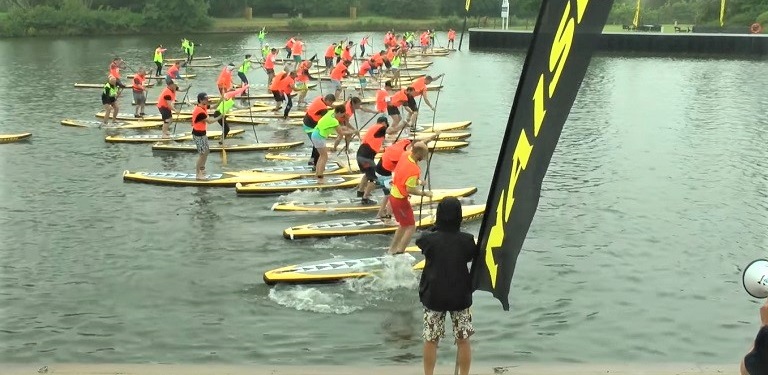
Designed for speed and stability, the profile of a racing board is similar to a touring board- long length with a pointed nose. However, they differ in width value. Racing boards are generally narrower than touring boards, making about 27 to 28 inches.
Fishing Boards:
Fishing boards feature a good grip deck, fishing rack systems, and are spacious, tough, and stable.
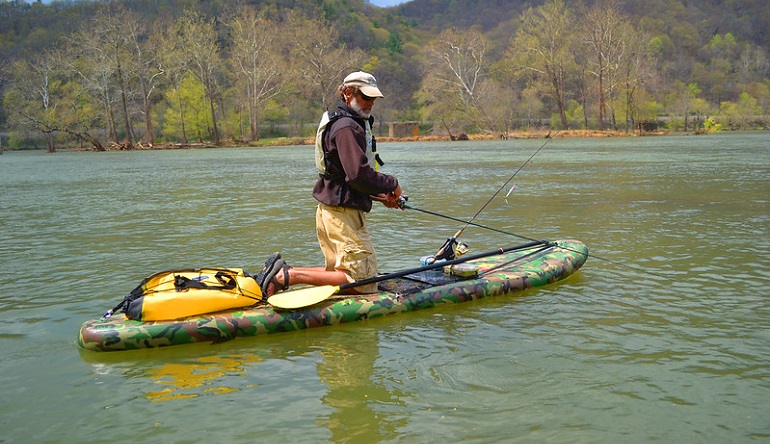
Surfing Paddle Boards:
They tend to be shorter, feature a pointed tail and nose, and a massive rocker. Such a profile advocates easy maneuverability, however, the speed is comparatively slow. Also, for such decks, stability is always a hard question.

Touring Boards:
As touring includes packing a lot of gear, boards designed for touring are wide (28 to 34 inches) and longer than all-around paddle boards. They are designed to serve you on flat water and in open ocean paddling.These paddle boards swank elongated noses to slice through the water without any resistance and increase the gliding movement. Not to mention, these boards prove less stable than many others.
Yoga Boards:
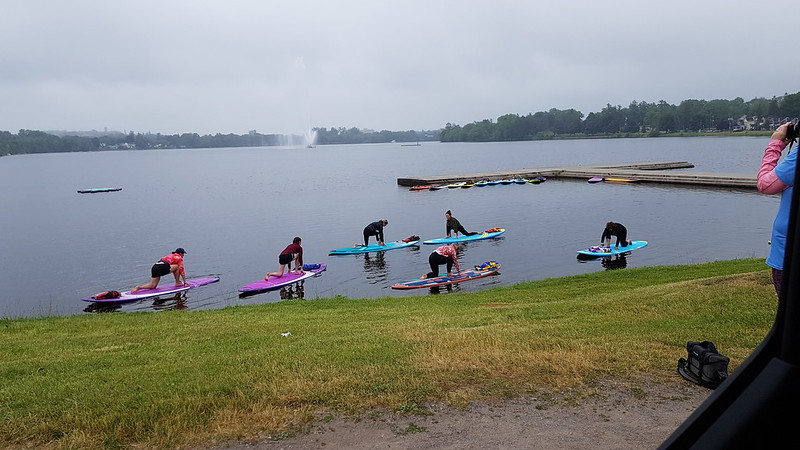
You cannot do yoga on a wobbly surface! Can you? Yoga paddle boards are wide enough to accommodate a person in holding a pose. Boards designed for yoga feature a flat deck cushioned enough to enable easy sitting, stability, and wide waists.
Whitewater Paddle Boards:
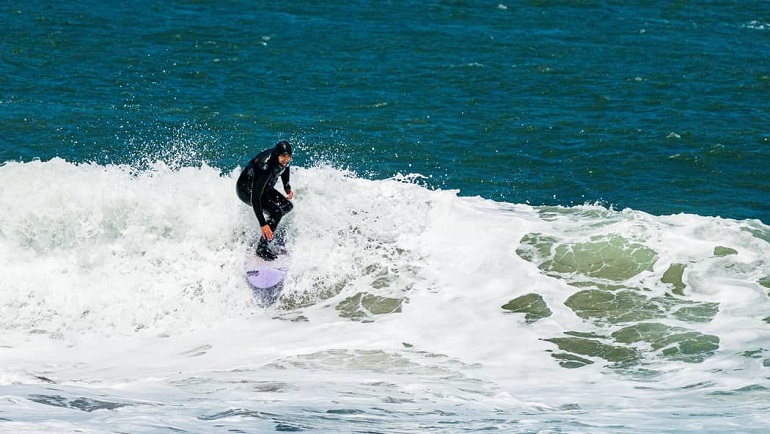
Features a lot of rocker, a long length for speed but not so long to hinder maneuvers, wide width, and a cutting-edge design.
All-Around Boards:
These are usually wide and voluminous (32 to 35 inches), hence offering bags of stability. All-around decks offer grip, traction, and comfort.

Below are mentioned all the possible activities that you can engage in using a SUP paddle board:
- Snorkeling and Diving
- Recreational paddling
- White water surfing
- Camping
- Fishing
- Expeditions
- Yoga
- Windsurfing
Same as for paddle boarding, there are numerous things you can do using a surfboard, and each activity is accommodated by a specifically designed surfboard. Your riding style determines the type you need. Let’s discuss some common types:
Gun Surfboards:

Designed to kill big waves, boasts epic speed tendency, buoyancy, and quad layout fins.
Foamie:
Ideal for beginners- soft boards feature a soft body that reduces chances for injuries.
Mid-length Boards:
7 to 8 feet long boards prove ideal for turn initiations (as compared to longer boards) while providing most of the perks of longer boards.

Shortboards/Thrusters:
Ideal for professionals: 5 to 6 feet long boards boasts top-tier performance. If you desire to surf fast and furiously, a thruster will do the work, as they are known for advocating high speed and maneuverability.
Fish Boards:

Features round tip and wider tail. Fish surfboards with shorter and wider profiles show high gliding abilities and carry fast speed. These surfboards feature only a drop of rocker.
Mini Simmons:
Suitable for weaker waves- if you have a thing for giving death to waves, but you are only a newbie, Mini Simmons can help you out here.
Grovellers:
3 or more inches shorter than a shortboard, a groveller features a flat rocker and a wide nose and tail. These surfboards are ideal for small waves.
Tow Boards:
Suitable for big waves- Swanking a length of 5 to 6 feet, tow-in surfboards own a quite slim body, pointy nose, and a wider tail. Tow boards support stability, speed, and control.
Foil boards:
These boards demand a hydrofoil to be attached to its bottom in order to hover over the water’s surface.
Dimensions (Length, Width, and Thickness)
The purpose renders the size of a board. As a paddleboard is expected to keep the rider afloat, it needs potential lift force. And volume provides that lift and stability. By volume, I mean the width, length, thickness, and hull shape.

That is exactly why paddle boards are thicker, wider, and longer than any typical surfboard. A typical paddleboard is 10 to 11 feet long and about 4 inches (foam boards) to 5 inches (inflatable paddle board) thick. The more the thickness, the better the buoyancy.
Let me further simplify the question of “why paddleboards are larger.” A quick short answer is that a paddleboard features a larger foam volume, at least 100 liters or above, which is mandatory for balance.
The chart given below mentions some common dimensions:
| SUP Type | Length | Width |
|---|---|---|
| All-around | Middle (10′ -12’6”) | Middle (30′-36′) |
| White water | Middle (7′-11′) | Middle to Wide (30′-36′) |
| Fishing | Middle (10′ – 12’6”) | Wide (32′-36′) |
| Yoga | Middle (10″-11″6″) | Wide (31′-36′) |
| Racing | Long(est) (11’6-14″) | Narrow (22′-30′) |
| Touring | Long (11′-14′) | Narrow (28′-34′) |
| Surfing | Short (7’8”-11’6”) | Narrow to middle (26′-32′) |
On the flip side, a typical surfboard is about 6 to 7 feet long or 8 to 11 feet also. It is narrower and slimmer than a paddle board as a surfer is expected to paddle with their arms on the board’s either side.
A short surfboard generally carries about 23 to 24 liters of foam in its core, while a longboard swanks a closer volume value to a paddle board- 85 liters typically.
However, unlike a paddleboard, you cannot stay afloat for longer hours on water using a longer surfboard. For further clarity regarding different surfboards, refer to the table given below:
| Surfboard Type | Length | Width |
|---|---|---|
| Gun | 6′ – 10′ | 18” – 26” |
| Fish | 5′ – 8′ | 18” – 25” |
| Foamine | 6’8”- 8’8” | 20′ -23” |
| Longboard | 8′ – 12′ | 22”-28” |
| Shortboard | 6’2” – 7’4” | 18′-22” |
Hull Materials
Let me tell you one thing, whatever watercraft you see floating on water has one of two types of hull: a displacement hull or a planing hull. Allow me to explain each one briefly.
Planing hulls are meant to be driven on water, and this tendency of floating on water is called planing. They tend to rise up and glide on the surface only. However, boards only plane while surfing a wave or going at high speed.
On the contrary, a displacement hull is intended to move underwater, and thus, it displaces the water. This type of hull has the aim of cutting through the water dexterously.
Only a paddleboard made of fiberglass features a displacement hull, all the rest own planing hulls. Surfboards feature planing hulls only.
Let’s shed some light on common hull materials. Generally speaking, we can divide boards into three categories, inflatable, open foam, and fiberglass.
Paddle Board Hull Materials
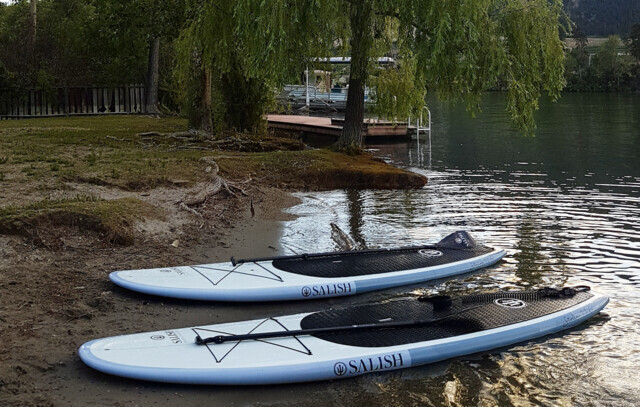
Paddleboards are mostly constructed using the following:
- Wood
- Plastic
- Inflatable and Made of PVC
- Soft Top
- Fiberglass/Epoxy Finish with EPS core
- Surfboard Hull Materials
Let’s see some hull materials for surfboards:
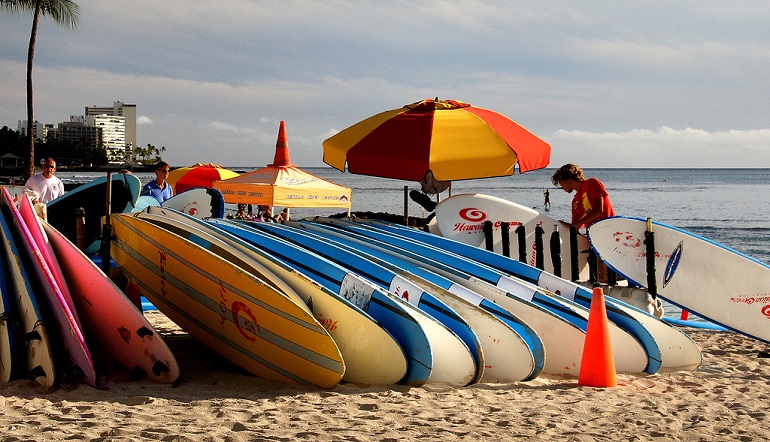
- Wooden
- Polyurethane
- Fiberglass/Epoxy
- Soft Top
You must be wondering why an inflatable surfboard is nowhere to be found. Well, you certainly will see one in a hundred.
The reason is, a surfboard demands a stern body to cut through the water. It should feature a sharp edge cut and a prominent rail design to enable riding through the waves.
So, they come as solid boards only, and strength is further stimulated through a stringer. A stringer is normally made out of wood or PVC. However, like sup paddle boards, the construction of a surfboard begins with a foam core also.
Mainly three foam types are being used for surfboards: extruded polystyrene (XPS), polyurethane (PU), and expanded polystyrene (EPS). Refer to the table given below to find what materials are usually used for paddle boards and surfboards.
| Material | Paddleboard or Surfboard |
|---|---|
| Inflatable PVC | Paddleboards only |
| Open foam | beginner and toy boards |
| Fiberglass, XTR and epoxy | Surf boards and high end paddleboards also |
| Fiberglass, EPS and epoxy | Surf boards and almost all paddleboards |
| Fiberglass, PU and Polyster | Surf boards only |
| Soft-top (Fiberglass, EPS) | Paddleboards only |
| Novelty materials | Some Paddleboards,Surf boards mostly |
Rocker and Rail Differences
While surfboards have 2 to 4 inches thick rails, paddle boards flaunt their rails ranging between 3 to 6 inches. That is exactly why paddle boards tend to be more voluminous than surfboards.
Let’s talk about rockers now. A rocker is a curvature of a board you see when you look at it from the side. It runs from one side (nose) to the other (tail). The more the rocker, the heavier the banana shape of the board.
Rocker helps in turning and maneuverability, and more rocker translates into better responsiveness. Just so you know, it is a must-feature for riding waves.
Paddleboards tend to have rockers designed in them mostly to assist the riders in keeping the board afloat. The rocker doesn’t let the nose of the deck sink in the water and drag.
Thus, rocker and wide profiles get necessary for paddle boarding. You know, the more surface area of contact, the more stability you get to enjoy.
Most surfboards feature moderate rockers. Even a minor difference in the rocker changes the performance of a board.
Short boards tend to have both nose and tail lifted to augment maneuverability, while longboards have little to no tail rocker for better tracking.
Flotation Differences
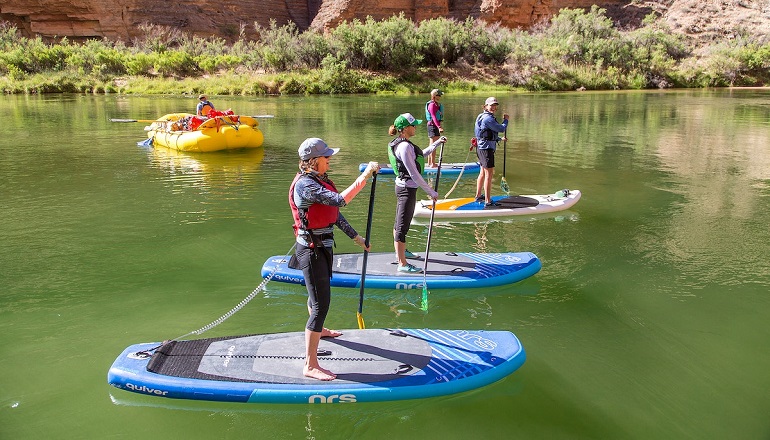
A surfboard isn’t required to have more buoyancy. Because while the goal of a paddle board is to keep you lifted above from the water, a surf deck aims to keep you more in the water in order to catch waves and ride waves.
There arises a difference in the floatation of both decks.
Paddle boards are more buoyant and thus glide along the wave smoothly. Surfboards are the least buoyant, with less foam in the core, hence, they rest ideal for killing waves. I mean, to sit on top of the wave isn’t the goal with surfboards. Rather, the goal is to maneuver.
Nose shape and Tail shape
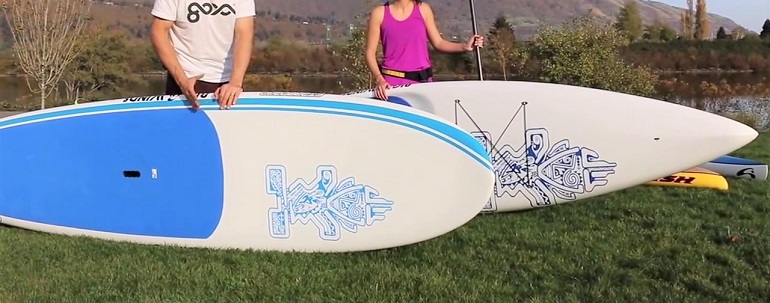
The nose stands important to your journey in the water. A pointed nose is a must-have for cutting water, while a more rounded nose is essential for lift.
Shortboards and surfing paddleboards boast pointed noses to enable navigation and slashing waves. The round nose provides more lift as this way, more of the length of the deck is touching the water’s surface.
The tail of a paddle board is usually square or squoval in shape. This shape assists in making pivot turns. On the other hand, a surfboard possesses a pintail.
Surfboard vs. Paddle Board Pricing
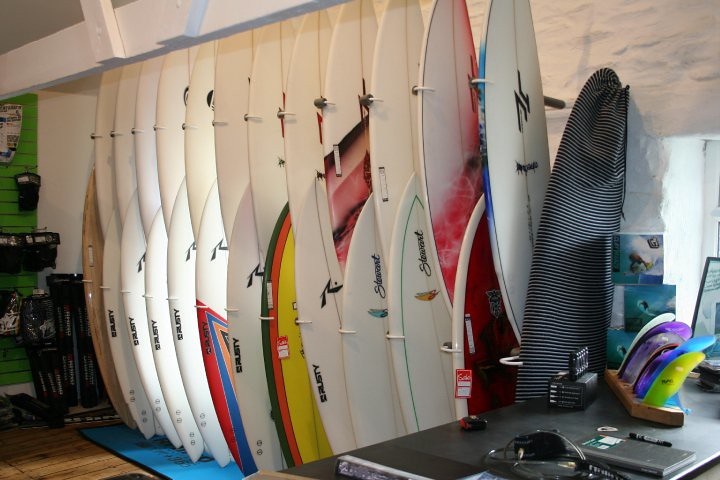
No big difference here! You can get a paddleboard for about 200 to 2000 dollars. Similarly, a surfboard also costs anywhere between $250 to $1500.
Can You Use a Surfboard as a Paddle Board?
Believe me when I say, the rocker, tail, and overall profile of the surfboard will give you a hard time while trying to paddle. But, a longboard might prove a fair substitute for a paddle board as long as you manage to maintain stability.
Can You Use a Paddle Board as a Surfboard?
It is not recommended to surf on big and heavy waves using a SUP paddle board. However, you can deal with smaller waves using a SUP deck.
Conclusion
One big difference between the two is that a paddleboard is a versatile deck, yet surfboards are specifically designed for surfing waves.
This thing makes paddleboards jacks of all trades and surf boards the specialized boards. Thus, the expectations result in a different construction of the boards.
Now that you have learned about the key differences between the two, you are ready to decide which sport is going to be your favorite.
0 Comments